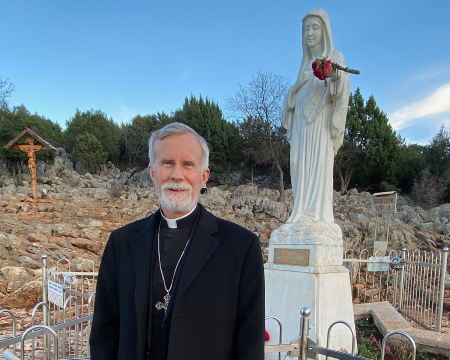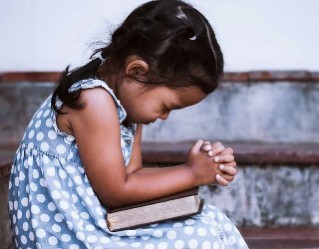Andrew Greenwell on Living the Faith: Dancing the Moral Dance
FREE Catholic Classes
In one of his sermons, St. Augustine of Hippo compares the Christian moral life to a dance, a dance to the song of the Gospel. There is some keen insight in St. Augustine's comparison of the moral life to a dance, and it merits some reflection.
 Hi readers, it seems you use Catholic Online a lot; that's great! It's a little awkward to ask, but we need your help. If you have already donated, we sincerely thank you. We're not salespeople, but we depend on donations averaging $14.76 and fewer than 1% of readers give. If you donate just $5.00, the price of your coffee, Catholic Online School could keep thriving. Thank you. Help Now >
Hi readers, it seems you use Catholic Online a lot; that's great! It's a little awkward to ask, but we need your help. If you have already donated, we sincerely thank you. We're not salespeople, but we depend on donations averaging $14.76 and fewer than 1% of readers give. If you donate just $5.00, the price of your coffee, Catholic Online School could keep thriving. Thank you. Help Now >
Highlights
Catholic Online (https://www.catholic.org)
7/22/2012 (1 decade ago)
Published in Living Faith
Keywords: morality, natural law, dance, St. Augustine
CORPUS CHRISTI, TX (Catholic Online) - In one of his sermons, St. Augustine of Hippo compares the Christian moral life to a dance, a dance to the song of the Gospel. "What a song that is, my brothers and sisters!" exclaims the great bishop. "You've heard me singing it, let us hear you dancing to it; see that you all do, by keeping time with your morals, what dancers do by keeping time with their bodies and their feet. Do this inwardly; let your moral attitudes match that song."
There is some keen insight in St. Augustine's comparison of the moral life to a dance, and it merits some reflection.
In what ways is the moral life like a dance?
Perhaps the most fundamental aspect of dance is that it requires movement, the movement of a human body. Dance is not a static affair, like a completed painting or a finished poem. It is an art form that is expressed through performance. It is this movement which expresses beauty. In Xenophon's Symposium, Socrates comments on the beauty of a body performing a dance. At rest, the boy may be said to be beautiful (kalos), but when he is in movement following the forms of the dance, he is more beautiful (kallion). Similarly, the moral life is performed through acts, human movement.
However, the moral life, like dance, is something clearly more than movement. It would be absurd to compare the spastic and involuntary movements of an epileptic in the throes of his seizures to the methodological movements of a human in a dance. Random movement is not dance. Random behavior is not moral.
O body swayed to music, O brightening glance,
How can we know the dancer from the dance?
The something more than movement required to know the dancer from the dance, the something which Socrates observed makes the dancer more beautiful, is form. Dance is movement subject to a form, which implies a rule or underlying order (ratio or logos). In dance, there is a reason--a ratio or logos--"behind" the movements, which we "see" with our reason. Dance to your heart's content in front of your dog or your cat. The animal will never understand what you are up to. The brute animal cannot grasp the form behind the movement. He can only grasp the movement.
Morality is just like dance in this regard. The moral life is composed of human acts--movement--that are governed by a form, and that form is the rule of right reason, which is to say the natural moral law.
That there is a form behind the movement, of course, suggests there is a meaning behind the dance, just as there is a meaning behind the moral life. Whatever the meaning, it is not utility. There is meaning behind the movement of a man who goes across the room to switch off a light, or who moves about the kitchen fixing his evening meal. But in no way are these utilitarian activities dance.
The moral life--like dance--is one of those "useless" human activities that have an intrinsic value, a value just in doing it, not necessarily by the pleasure it brings or the benefits it yields.
Labour is blossoming or dancing where
The body is not bruised to pleasure soul.
Though one may get collateral benefits from engaging in the activity--physical health in the case of dancing, happiness or pleasure in the case of the moral life--the activity is not measured by the benefits.
We might say the "useless" purpose of dance is to express beauty. Though it might not be at first apparent, beauty is also fundamental to the moral life. "Beauty is truth, truth beauty," wrote Keats in his famous poem. One might also say, "Beauty is good, good beauty," and good is what the moral life seeks.
Immanuel Kant recognized the relationship between beauty and morality. Famously, Kant wrote that beauty was a symbol of morality. He saw four similar elements between beauty and morality that justified this view.
First, beauty and morality please the sensitive person immediately, though in the first case one must have artistic sensitivity and in the latter case moral sensitivity. Dance, like the moral life, is often something that involves acts that are fitting, graceful, fluid, and elegant which only the sensitive perceive. There is such a thing as an aesthetically or morally coarse or obtuse person. We can have bad taste, and bad morals.
Second, Kant states that both beauty and morality are disinterested in the sense that beauty and morality are not measured by what we get out of it. Both dance and the moral life have intrinsic or "useless" value as we mentioned earlier.
Third, Kant points to the fact that both beauty and morality answer to a rule. In some way, there is a conformity to an underlying law, and ideal, the form.
Finally, though Kant believed that both beauty and morality are universal, he observed that it is very difficult for us to enunciate the universal principle. It is difficult to define beauty in all times and all places, just like it is to determine the good in all times and all places. That does not mean beauty in dance and beauty or good in morality do not exist. To perceive beauty or the good, a certain level of well-formed judgment--both intellectual and practical--is required. One might say that the beauty in dance and the beauty in morality both require a form of prudence.
That brings us to the next similarity between dance and the moral life: both dance and the moral life seek perfection or excellence, what the Greeks understood as arete, the Romans described as virtus, and we translate as virtue. And like any human activity, perfection or excellence requires practice.
Since dance is the movement of a body that is subject to an intellectual rule, it must be practiced to gain facility in it. And this means that there can be improvement: one can dance poorly, and one can dance well, and practice--as well as perhaps native talent, and a good instructor--makes us better. No one can dance a waltz or the tango well at first, but with practice one gains a facility where it becomes a sort of second nature, an intimate possession. The movement then becomes connatural. It is "stored" in us, we have "muscle memory," and becomes what philosophers would call a hexis or habitus, a notion which is only poorly captured by the English word habit.
In this regard, the moral life is no different than dance. To become virtuous one must do more than just act natural like Rousseau erroneously advocated. The virtuous life requires practice, and that requires the formation (learning the form of the dance) and the development of good habits through practice (asceticism, which comes from the Greek word askesis, which means exercise or training) so that these good behaviors become a second nature, habitual.
Additionally, like the moral life dancing is more than a mere intellectual activity. It requires the commitment of the whole person. A dancer--at least if he or she strives for excellence--must do something more than exhibit a lackadaisical conformity with an external form. Dancing is more than just mimicry, routine, or ritual. The dancer must strive for more than mere technical mastery. Dancing is more than just going through the motions. It demands that one be "into" it, that one's heart be "in" it.
The common element of form shared by the moral life and dance means that there must be a formgiver. In dance, the formgiver is the choreographer. In the moral life, the formgiver is God, whose will is known through nature and revelation. The existence of form and formgiver makes dance, like the moral life, not something that "is." Both dance and the moral life are activities that have an "ought" attached to them. "The minuet," the dance instructor can say, "ought to be danced like this, and not like this." For the same reason, the Church can say, "sexual activity ought to be done like this, and not like this."
We ask you, humbly: don't scroll away.
Hi readers, it seems you use Catholic Online a lot; that's great! It's a little awkward to ask, but we need your help. If you have already donated, we sincerely thank you. We're not salespeople, but we depend on donations averaging $14.76 and fewer than 1% of readers give. If you donate just $5.00, the price of your coffee, Catholic Online School could keep thriving. Thank you.Help Now >
The Scriptures and the Saints seem to recognize the relationship between the moral life and dance.
When the prodigal son returns home to a moral life after a life of dissipation, the Father throws a dance. (Luke 15:25).
The dance of the moral life participates in the eternal. After all, the form of the moral life--the natural moral law--participates in the Eternal Form, the Eternal Law, as St. Thomas teaches us.
In the traditional English carol, "Tomorrow Shall Be My Dancing Day," the Son of God becomes incarnate "to call my true love to my dance," is tempted by the Devil in the desert "to have me break my true love's dance," was brought before Pilate and judged "to die to lead to the dance," suffered death on the cross and the piercing of the lance "to call my true love to my dance," and will come again in glory to judge the living and the dead "that man may come unto the general dance."
In one of his letters, St. Basil refers to the dance of the angels in heaven. And the saints in Dante's Divine Comedy dance in heaven. The Paradiso is full of dance scenes. The Greek Orthodox Bishop Kallistos Ware describes the relationship between the Father, Son, and Holy Spirit as "an unceasing movement of mutual love - the 'round dance' of the Trinity." It would seem that in heaven everyone is dancing.
Since we apparently are going to be dancing in heaven, we may as well learn to dance on earth.
Let us praise His name in the moral dance (cf. Ps. 149:3)
-----
Andrew M. Greenwell is an attorney licensed to practice law in Texas, practicing in Corpus Christi, Texas. He is married with three children. He maintains a blog entirely devoted to the natural law called Lex Christianorum. You can contact Andrew at agreenwell@harris-greenwell.com.
---
'Help Give every Student and Teacher FREE resources for a world-class Moral Catholic Education'
Copyright 2021 - Distributed by Catholic Online
We ask you, humbly: don't scroll away.
Hi readers, it seems you use Catholic Online a lot; that's great! It's a little awkward to ask, but we need your help. If you have already donated, we sincerely thank you. We're not salespeople, but we depend on donations averaging $14.76 and fewer than 1% of readers give. If you donate just $5.00, the price of your coffee, Catholic Online School could keep thriving. Thank you.Help Now >









 Daily Readings for Saturday, April 20, 2024
Daily Readings for Saturday, April 20, 2024 St. Marian: Saint of the Day for Saturday, April 20, 2024
St. Marian: Saint of the Day for Saturday, April 20, 2024 Children's Prayer For Parents: Prayer of the Day for Saturday, April 20, 2024
Children's Prayer For Parents: Prayer of the Day for Saturday, April 20, 2024


